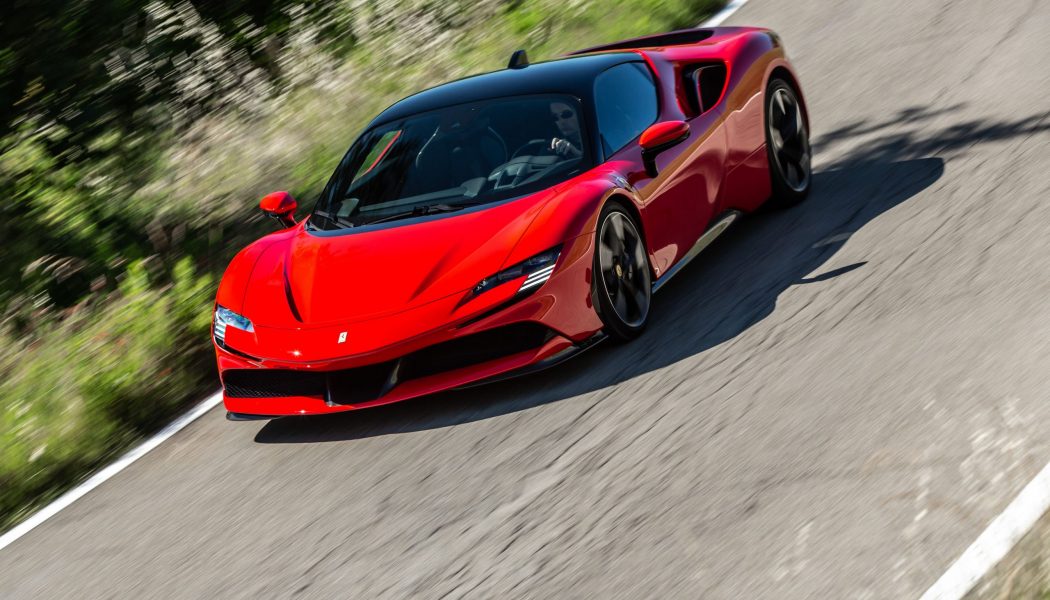“On the road, things happen much faster than in the 488 Pista,” claims test driver Raffaele de Simone of the 2021 Ferrari SF90 Stradale. “Train your neck and your reactions,” he says, hinting that Ferrari’s new 986-hp high-tech hypercar will generate truly prodigious levels of grip while feeling as fast and agile as a race car. “You can go through corners so much quicker.”
The SF90 is a benchmark Ferrari. It is the most powerful Ferrari road car yet. It’s also the quickest, with a claimed 0-60 mph acceleration time of less than 2.5 seconds, with the 0-124 mph sprint taking just 6.7 seconds. So far, so Maranello … But here’s where it gets really interesting. The SF90 is the first flagship Ferrari since the F40 not to have a V-12 engine. What’s more, it’s also the first ever plug-in hybrid Ferrari, the first all-wheel-drive mid-engine Ferrari, the first Ferrari to use brake-by-wire technology, and the first Ferrari sports car fitted with electric power steering.
That smell? Tradition, smoldering in a dumpster. It might have the old-school prancing horse shield on the front fenders and the drive select buttons arranged in a structure on the center console designed to look like the iconic metal shiftgate, but the SF90 is very much a Ferrari of the here and now, a road car clearly developed by a company whose Formula 1 team is part of its in-house design and engineering expertise and not the result of an expensive sponsorship deal. “It represents the pinnacle of what Ferrari is capable of doing,” says SF90 product manager Matteo Turconi.
Let’s take a closer look.
The Ferrari SF90 Stradale’s Plug-In Hybrid Powertrain
The SF90’s hybrid powertrain comprises a mid-mounted twin-turbo V-8 engine that develops 769 hp and 590 lb-ft of torque, three electric motors, and a mid-mounted high-voltage battery. One e-motor is mounted between the engine and the new eight-speed dual-clutch automatic and develops 157 hp and 196 lb-ft of torque. The two other e-motors are mounted at the front axle, driving the front wheels, and each develops 97 hp and 62 lb-ft of torque. The liquid-cooled single-module 8-kW-hr battery weighs just 158 pounds, and it allows the SF90 to travel up to 15 miles on pure electric power, using the front motors, at speeds of up to 84 mph.
REVISED V-8 ENGINE
Although the SF90’s V-8 is a member of the F154 engine family, which debuted in the California T and has been used in the 488 and F8 Tributo, it has been significantly upgraded. New cylinder heads feature redesigned combustion chambers with centrally mounted injectors that deliver a 7 percent increase in combustion pressure, increasing power. As a result, capacity has increased slightly from 3.9 liters to 4.0 liters.
Other changes include a new crank, new conrods, new pistons, new camshafts, a new intake system—the plenums are virtually bolted to the heads—and a new exhaust. The turbos are the same size as on the F8 Tributo, but revised compressor scrolls facilitate increased airflow. The new parts reduce the engine’s weight by 55 pounds and have reduced overall height by 12 percent, helping lower the car’s center of gravity.
Nicknamed the “pizza motor” by Ferrari engineers, the main e-motor, called P1, is sandwiched between the rear of the V-8 internal combustion engine and the front of the new eight-speed dual-clutch transmission. Ferrari claims the axial flux technology used in the motor is a world first in terms of a production car. An axial flux motor means the disc-like rotors are coaxially mounted on either side of a flat stator (conventional e-motors have a rotor that spins inside a tubelike stator). In the Ferrari motor, the rotors are made of a stainless-steel substrate, an iron laminate, and with array of magnets adhesively bonded to them. Just 2.8 inches deep and weighing 48 pounds, the P1 e-motor is extremely power dense, capable of producing 157 hp and 196 lb-ft of torque.
The two e-motors driving the front wheels of the SF90, called P4s, are conventional in design, with hairpin-wound rotors spinning inside a fixed stator case. “It’s a relatively tried and tested technology, but evolved to allow small diameters and high speeds,” says head of powertrain Vittorio Dini. The water-cooled motors weigh just 26 pounds each and will spin to 25,000 rpm. They drive the front wheels through what Ferrari describes as “a cascaded cylindrical and planetary geartrain” that allows the motors to propel the SF90 to 84 mph in pure electric power mode, the torque to each wheel to be independently varied, and for both e-motors to be disengaged at speeds above 130mph. The SF90 is thus a front-wheel-drive, all-wheel-drive, or rear-wheel-drive car, depending on the drive mode and driving conditions.
TRANSMISSION
The SF90’s eight-speed dual-clutch transmission is all new and will eventually appear across the Ferrari lineup. It has been designed to allow the engine to sit lower in the chassis than the seven-speeder used in the F8 Tributo and can handle 96 lb-ft more torque. The taller eighth gear helps reduce fuel consumption by 5 percent, and a dry-sump oil system that allows the use of a single oil for both lubrication and hydraulic actuation instead of the two oils used in the seven-speed cuts it by a further 3 percent. The new transmission is also 15 pounds lighter overall than the old seven-speed, but Ferrari has lightened it a further 6 pounds in the SF90 by taking out the reverse gear set; select reverse, and the front e-motors push the car backwards.
DIGITAL DRIVER INTERFACE
In addition to a new transmission, the SF90 debuts a digital dash and driver interface that will also eventually appear in future Ferraris. The centerpiece of the system is a fully configurable digital instrument panel on a 16-inch, full HD, freeform curved screen. An industry first, says Ferrari’s head of HMI and ergonomics, Maximilian Romani. The screen is flanked by pods that come within fingertip reach of the steering wheel. Touch controls on the right pod adjust the HVAC functions; those on the left pod are for light and exterior mirrors. A head-up display, the smallest yet developed for a sports car, says Ferrari, projects information in high resolution onto the windshield.
“Eyes on the road, hands on the steering wheel.” That’s the mantra behind the development of the new driver interface system, says Ferrari, and a new steering wheel with capacitive touch switches and a small touchpad is an integral part of the system. There is no start-stop button. Just touch the icon above the third spoke twice, and the SF90 is ready to glide away on its electric motors, with Hybrid mode being the default driving mode. Romani says that compared with an 812 Superfast, the new interface reduces the time the driver has to glance away from the road by 36 percent, and the time taken to complete a task by 26 percent.
E-MANETTINO
Ferrari’s now familiar Manettino drive mode switch is in its usual place, just to the lower right of the steering wheel boss. But the SF90’s PHEV powertrain adds an extra layer of complexity and capability to the menu. These additional modes are controlled by a cluster of touch switches just to the lower left of the steering wheel boss dubbed eManettino.
The SF90’s eDrive mode means the Ferrari will drive on the front e-motors only. Hybrid mode is the default setting, with the computers switching the energy flows between the twin-turbo V-8 and e-motors as appropriate. Performance mode keeps the internal combustion engine running at all times to keep the battery charged and e-power instantly available. And Qualifying mode will ensure the powertrain gives the full 986 hp for as long as there’s charge in the battery. It’s good for about six or seven laps of Ferrari’s Fiorano test track or one lap of the 12.9-mile Nürburgring Nordschleife, says Stefano Varisco, head of vehicle dynamics.
Aerodynamics and the SF90
To optimize the SF90’s shape not just for performance but also for hybrid and e-motor running and to assist with the thermal management of the PHEV powertrain, Ferrari spent 50 percent more time in the wind tunnel honing the aerodynamics than it did with the LaFerrari. “It is the most aerodynamically efficient car in the Ferrari range,” says head of aerodynamics Matteo Biancalana. Up front, the central intake cools the front e-motors, while the intakes either side are for cooling the V-8 engine. Borrowing from F1 experience, the front floor has been raised 0.6 inch to fit larger vortex generators under the car, increasing downforce on the front axle by 30 percent.
The most innovative aerodynamic element is at the rear of the car. In normal low-drag mode, air flows over the cabin and exits through a vent between the taillights. In high-downforce mode, the central element of the wing drops down and stops that flow, effectively creating a giant Gurney flap. The patented system is said to develop 860 pounds of downforce at 186 mph. Raising the central element back into place for low-drag mode requires less effort, Ferrari says, because it essentially floats on the airflow and engineers were able to reduce the weight of the actuators by 66 percent.










